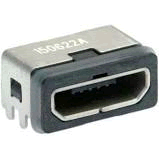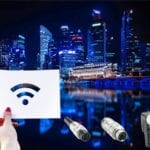Smart-Home Technology for the Disability Community
A new wave of connector-rich technologies are giving greater independence to people with disabilities
By Adam Wahlberg
When Mark Siegel wants to play music in his Minneapolis condo, he twitches his left ear. This is how he controls his iPad, which is how he manages his home environment. To him it’s all quite remarkable. “I spent most of my life relying on nurses to do just about everything for me,” he says. “This is so much better.”
Siegel, 46, was born with spinal muscular atrophy, which is a genetic disease that impairs muscle movement. A ventilator fills his lungs and nurses assist him 24 hours a day, just not as actively as they used to. In fact, once he gets home, he pretty much just needs them to fasten his iPad earbud. After that, all he needs to do is scrunch his face like Samantha on “Bewitched” and Apple’s Switch Control technology allows him to click on his tablet. Voila. Broken Social Scene starts playing. He also turns on lights this way, controls the temperature, pays bills, and more. Switch Control, which launched in 2013 as part of iOS, is an accessibility feature that enables people to navigate and activate iOS touchscreen devices using subtle body movements, and it has greatly enhanced his life as well as the lives of so many others.

Mark Siegel finds better living through the Internet of Things. (Photo by Larry Marcus)
Siegel is one of 57 million Americans with a disability, according to the American Association of People With Disabilities. Europe counts another 80 million people with disabilities, and millions more live in countries around the world. This is a significant population with specialized needs. As the population in many countries ages, the percentage of people living with a disability will only increase. This makes smart-home technology solutions, all made possible by advanced connector technologies, urgent.
Apple’s suite of products is well reviewed for its accessibility. But Amazon is catching up, thanks to its popular voice-activated functions. A primary device, such as an iPad, can control other devices that use Bluetooth-enabled switch hardware. Siegel prefers switch-control technology to voice activation because his voice, which is thin and halting, doesn’t easily register with devices. But for many people with a disability, voice activation is a game-changer. That’s where Amazon’s Echo program shines.

Amazon Echo
Echo is a personal assistant device that sits on the table and listens for your commands, and then activates Bluetooth-enabled devices and appliances. Through that chain of command, you can activate programs such as Ask My Buddy, which is free to enable and allows consumers to send out alerts to contacts. It can also help you control your TV. Want to watch “Stranger Things?” Just ask Alexa to start playing it. An array of sensors, connectors, ribbon cables, and other micro-sized components enable people to control devices just by asking.

TE’s compressive board-to-board connectors are used in tablets, phones, video cameras, and more.
These devices and other players in the Internet of Things (IoT) — or, in some cases, the Internet of Medical Things (IoMT) — rely on connectors, sensors, power supplies, signal I/O, Wi-Fi, and Bluetooth connectivity to transmit and receive information at each point. While the functions are accomplished through seemingly invisible means, a very real array of sensors and actuators support every move. Companies like Molex, TE Connectivity, Amphenol, Hirose, JAE, Kycon, AVX, and others are providing the physical connections that make the invisible connections possible.

The ubiquitous mini-USB connector — this one by Molex — is found across the IoT.
From capacitive switches and LED displays to antennas and USB connectors, connectors and electronic components support the burgeoning wireless market, which has quickly become essential for the many disabled people who rely on IoT technologies to improve their lives.
The industry’s innovations include an M.2 card edge connector, which accepts dual-side modules, allowing for functionality in device-size products. Wireless compatibility is also now possible through wireless module cards, which can deliver BT, WLAN, up to 4G, and GPS solutions to devices.
For years, the size of a product’s printed circuit board (PCB) was a dominating component in the small package sizes of a lightweight phone. But today, creative, reliable, and cost-effective component solutions are minimizing the size of a PCB. A PCB’s profile height is now as small as 1.8mm — while simultaneously increasing functionality.
Apple and Amazon may be the leaders on disability technology, but they aren’t the only ones. In fact, they depend on a host of other companies to develop the smart technologies that make it easy for people to control their environment, improve their comfort, and interact with the world. Here are some of the IoT devices that people with disabilities can call into action.
Smart Locks

The August Smart Lock can be opened with a phone.
A smart lock is a safer alternative to a keypad, especially if you need to give a housekeeper or nurse access to your home. The August Smart Lock is one example of a door lock that can be opened with either a conventional key or a smart phone, allowing the owner to give others a temporary, guest, or admin access. Users can restrict the number of times and days someone has access to their home, while monitoring who has entered in a log. It’s Bluetooth- and Wi-Fi-ready, interfaces with Apple’s HomeKit software, and can be controlled whether or not the user is at home. Inside these devices, an array of connectors bring functionality, including battery connectors, control connectors, and REM port connectors.
Smart Doorbells
For those who are confined to bed, or are unable to see out of their windows from their wheelchairs, a smart doorbell is handy. The Ring Smart Doorbell, for instance, comes with a motion-sensor camera and shows who is at the door, allowing users to decide whether or not to answer. The power and signal is managed for the slim PCB through ultra-miniature cables and connectors. A micro-USB may be present for charging or connecting to other devices to move data.
Smart Thermostats
Smart thermostats, such as the Nest, keep users house at the exact temperature they want and allow them to change the temperature with their smart phone, even when they’re away or via a preprogrammed schedule. A series of sensors deliver information about temperature, humidity, and light. Spring-loaded connectors route signal lines to a home’s heating and cooling devices. The Nest features a micro USB port for charging, and a proprietary 20-pin connector that locks the devices onto the base unit.
Smart Lighting
Smart lighting like Philips Hue Light Bulbs don’t just turn on and off; these lights can also change hues and be dimmed to decrease sensory overload, which is a common challenge for many people living with disabilities. Inside these light bulbs, a tiny system includes a circuit board, radio transceiver, AC/DC converter, capacitor, EPROM, and transformer.
Smart Curtains, Shades, and Blinds
Operating curtains and shades can be difficult for people with restricted mobility, but smart window coverings can help. My Smart Blinds, for example, can control blinds with audio as well as smart phone commands. A motor is at the heart of these systems, although the most sophisticated versions also include a sensor array to monitor and respond to light conditions.
With technology, accessibility is evolving in ways that many in the disability community deemed unimaginable a generation ago. “My life is so much different than my childhood and really, most of my adult life,” Siegel says. “I can’t wait to see what comes next.”
Adam Wahlberg’s work has appeared in Minnesota Law & Politics, Twin City Business, Delta Sky, and many other publications. He is the founder of Think Piece Publishing.
Recently posted:
[related_posts limit=”10″]






